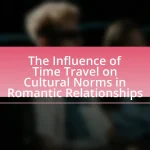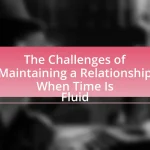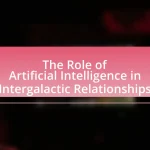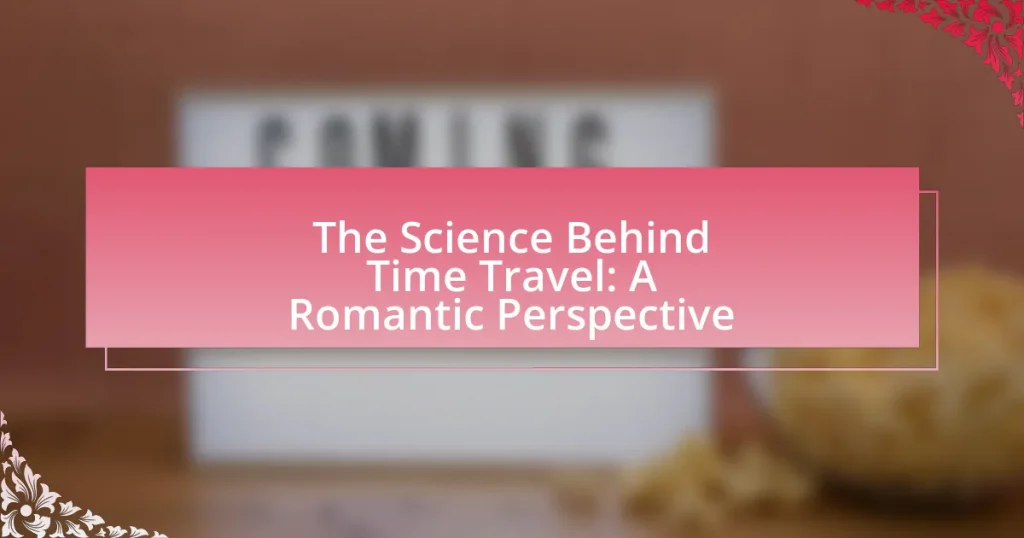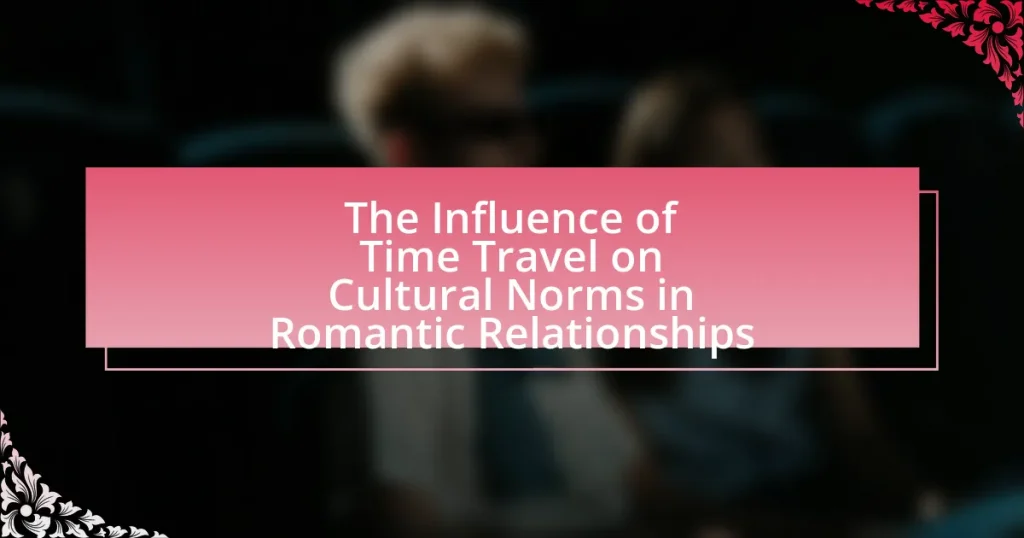The article focuses on creating compelling characters in time travel romance stories, emphasizing key elements such as strong motivations, distinct personalities, and relatable conflicts. It explores how time travel mechanics influence character development and the impact of different types of time travel on emotional arcs. Additionally, the article discusses the significance of characters’ backgrounds, historical context, and cultural differences in shaping their experiences and interactions. It also highlights common pitfalls in character creation and offers practical tips for writers to ensure character growth and balance romance with time travel challenges, ultimately enhancing the narrative’s depth and engagement.
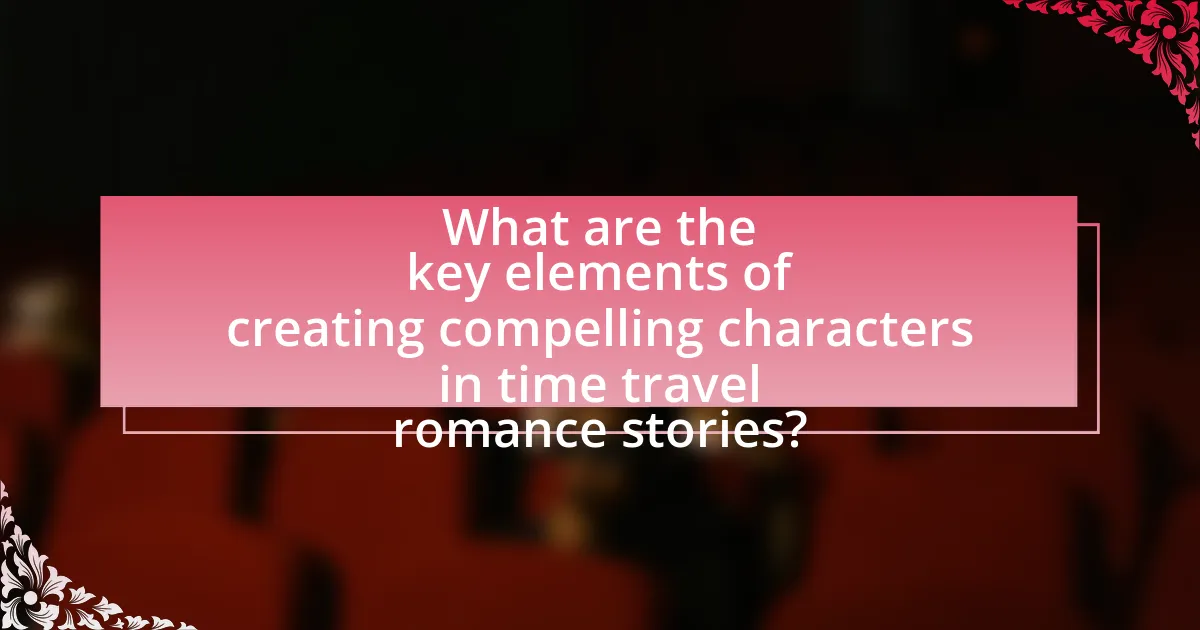
What are the key elements of creating compelling characters in time travel romance stories?
The key elements of creating compelling characters in time travel romance stories include strong motivations, distinct personalities, and relatable conflicts. Strong motivations drive characters to pursue their goals across different timelines, making their journeys engaging. Distinct personalities help readers connect with characters, as unique traits and backgrounds create depth. Relatable conflicts, such as navigating love across time periods or dealing with the consequences of time travel, enhance emotional stakes and keep readers invested. These elements work together to create multidimensional characters that resonate with audiences, ensuring a captivating narrative.
How do time travel mechanics influence character development?
Time travel mechanics significantly influence character development by allowing characters to experience different timelines, which can lead to personal growth and transformation. For instance, characters may confront their past mistakes or explore alternate versions of themselves, prompting introspection and change. This dynamic is evident in narratives like “The Time Traveler’s Wife,” where the protagonist’s experiences across time deepen their emotional complexity and relationships. Such mechanics create opportunities for characters to evolve in response to their unique temporal challenges, ultimately enriching their arcs and enhancing the story’s emotional resonance.
What types of time travel exist and how do they affect characters?
There are primarily three types of time travel: linear, branching, and looped time travel, each affecting characters in distinct ways. Linear time travel allows characters to move forward or backward in a straight timeline, often leading to direct consequences for their actions, such as altering past events that impact their present. Branching time travel creates alternate timelines, enabling characters to explore different outcomes without affecting their original timeline, which can lead to complex emotional dilemmas as they confront choices and their repercussions. Looped time travel involves characters reliving the same period repeatedly, often resulting in character growth or frustration as they seek to break the cycle, ultimately influencing their motivations and relationships. These types of time travel shape character development, emotional arcs, and the narrative structure in time travel romance stories.
How can characters’ backgrounds shape their time travel experiences?
Characters’ backgrounds significantly shape their time travel experiences by influencing their motivations, perceptions, and adaptability to different historical contexts. For instance, a character with a rich historical knowledge may navigate past eras more effectively, understanding cultural nuances and avoiding potential pitfalls. Conversely, a character from a technologically advanced background might struggle to adapt to simpler times, leading to conflict and growth. Additionally, personal traumas or societal roles can affect how characters respond to the challenges of time travel, as seen in narratives where a character’s past informs their choices and relationships in different timelines. This interplay between background and experience enriches the narrative, providing depth and realism to the time travel journey.
What role do emotional arcs play in character creation?
Emotional arcs are crucial in character creation as they provide depth and relatability to characters, allowing audiences to connect with their journeys. These arcs illustrate the transformation a character undergoes, often reflecting their internal struggles and growth throughout the narrative. For instance, a character who starts as insecure may evolve into a confident individual by the story’s end, showcasing resilience and personal development. This transformation is essential in time travel romance stories, where characters often face unique challenges that test their emotional limits, making their arcs pivotal for engaging storytelling.
How can a character’s emotional journey enhance the romance aspect?
A character’s emotional journey can significantly enhance the romance aspect by deepening the connection between the characters and making their relationship more relatable and impactful. When a character experiences growth, vulnerability, or transformation, it allows for a richer exploration of their feelings and motivations, which can lead to more intense romantic interactions. For instance, a character overcoming personal trauma can create a compelling backdrop for romance, as their newfound strength can attract a partner who appreciates their resilience. This dynamic often resonates with audiences, as emotional depth in characters fosters empathy and investment in their romantic outcomes.
What techniques can be used to develop relatable emotional arcs?
To develop relatable emotional arcs, writers can utilize techniques such as character backstory, emotional triggers, and conflict resolution. Character backstory provides depth, allowing readers to understand motivations and emotional responses, which fosters relatability. Emotional triggers, such as loss or love, resonate with audiences, creating a connection to the character’s journey. Conflict resolution, where characters face and overcome challenges, illustrates growth and transformation, making the emotional arc more impactful. Research indicates that well-crafted emotional arcs enhance reader engagement and investment in characters, as seen in successful narratives across various genres.
How can historical context enrich character depth?
Historical context enriches character depth by providing a framework for understanding characters’ motivations, beliefs, and behaviors shaped by their time period. For instance, a character living during the Victorian era may exhibit values and social norms that reflect the strict class structures and gender roles of that time, influencing their decisions and relationships. This contextual backdrop allows readers to grasp the complexities of the character’s actions and choices, making them more relatable and multidimensional. Historical events, such as wars or social movements, can also serve as catalysts for character development, revealing how external circumstances impact personal growth and relationships.
What research methods can authors use to create authentic historical characters?
Authors can use primary and secondary research methods to create authentic historical characters. Primary research involves analyzing original documents, letters, diaries, and artifacts from the historical period, which provide firsthand accounts and insights into the lives and thoughts of individuals from that time. Secondary research includes studying historical analyses, biographies, and scholarly articles that interpret and contextualize historical events and figures, allowing authors to understand the broader societal norms and values of the era. For instance, examining the letters of historical figures can reveal their personal motivations and emotions, while scholarly works can provide context about the political and social climate, ensuring that characters are portrayed accurately and authentically.
How do cultural differences impact character interactions across time periods?
Cultural differences significantly impact character interactions across time periods by shaping values, communication styles, and social norms. For instance, characters from a Victorian era setting may exhibit formal manners and strict gender roles, while modern characters might prioritize equality and casual communication. This divergence can lead to misunderstandings or conflicts, as seen in literature where a time traveler struggles to adapt to the customs of a different era, highlighting the contrast in societal expectations. Historical context, such as the evolution of gender roles from the 19th century to today, illustrates how these cultural shifts influence character dynamics and relationships.
What are common pitfalls in character creation for time travel romance?
Common pitfalls in character creation for time travel romance include inconsistent character motivations, lack of historical accuracy, and failure to address the implications of time travel on relationships. Inconsistent motivations can confuse readers, as characters may act in ways that contradict their established goals or personalities. Lack of historical accuracy can alienate audiences who expect authenticity in time periods, leading to a disconnect between characters and their settings. Additionally, failing to explore how time travel affects emotional connections can result in superficial relationships that lack depth, undermining the romance aspect. These pitfalls can detract from the overall narrative and character development, making it crucial for writers to carefully consider these elements.
How can clichés be avoided when developing characters?
Clichés can be avoided when developing characters by creating unique backstories and motivations that reflect individual experiences. By focusing on the specific traits, desires, and conflicts of each character, writers can ensure that their characters are distinct and relatable. For instance, instead of relying on the archetype of the “damsel in distress,” a character could be portrayed as a resourceful individual who actively seeks to change her circumstances. This approach not only enhances character depth but also engages readers by presenting fresh perspectives.
What strategies can be employed to ensure character growth throughout the story?
To ensure character growth throughout the story, writers can employ strategies such as establishing clear character arcs, introducing challenges that force characters to confront their flaws, and allowing for meaningful relationships that influence development. Clear character arcs provide a roadmap for growth, showing how characters evolve from their starting point to a more developed state. Introducing challenges, such as moral dilemmas or time travel consequences, compels characters to make difficult choices, fostering personal growth. Additionally, meaningful relationships with other characters can serve as catalysts for change, as interactions can reveal vulnerabilities and encourage self-reflection. These strategies are supported by narrative theory, which emphasizes the importance of conflict and relationships in character development.
How can authors effectively balance romance and time travel elements in character development?
Authors can effectively balance romance and time travel elements in character development by ensuring that the emotional stakes of the romance are intertwined with the consequences of time travel. This means that character motivations should reflect both their romantic desires and the complexities introduced by time travel, such as altering timelines or facing historical challenges. For instance, a character’s decision to pursue a romantic relationship can be influenced by the potential risks of changing the past or future, creating tension and depth in their development. By establishing clear connections between the romance and time travel elements, authors can create a cohesive narrative that enhances character growth and emotional engagement.
What techniques can be used to intertwine romance with time travel challenges?
Techniques to intertwine romance with time travel challenges include creating emotional stakes, utilizing paradoxes, and establishing character development arcs. Emotional stakes can be heightened by placing characters in situations where their romantic choices impact their timelines, such as choosing between love and duty. Paradoxes, like meeting a past or future version of a partner, can create tension and conflict, enriching the romantic narrative. Character development arcs should reflect the growth of relationships over time, emphasizing how time travel influences their bond, as seen in narratives like “The Time Traveler’s Wife,” where love endures despite temporal obstacles. These techniques effectively blend romance with the complexities of time travel, enhancing the overall storytelling experience.
How can character relationships evolve through different timelines?
Character relationships can evolve through different timelines by experiencing varied circumstances, choices, and personal growth that influence their interactions. For instance, in time travel narratives, characters may meet at different ages or stages in their lives, leading to distinct dynamics based on their maturity and life experiences. This evolution can be illustrated through contrasting timelines where a character’s past decisions shape their future relationships, such as a character who initially rejects love in one timeline may embrace it in another after learning from past mistakes. The complexity of these interactions can deepen emotional connections, as characters navigate the consequences of their actions across timelines, ultimately enriching the narrative and character development.
What practical tips can help writers create compelling characters in time travel romance stories?
Writers can create compelling characters in time travel romance stories by ensuring that each character has a distinct motivation that drives their actions across different timelines. This motivation should be deeply rooted in their personal history and emotional needs, allowing readers to connect with them on a relatable level. For instance, a character’s desire to reunite with a lost love can serve as a powerful catalyst for their time-traveling adventures, making their journey both meaningful and engaging.
Additionally, writers should develop characters with contrasting traits that create tension and chemistry, such as a pragmatic individual paired with a free-spirited partner. This dynamic can enhance the romantic aspect of the story while also providing opportunities for character growth.
Furthermore, incorporating historical accuracy and cultural context into character backgrounds can enrich the narrative. For example, a character from the Victorian era may have different societal constraints and expectations compared to a modern character, which can lead to intriguing conflicts and interactions.
Lastly, allowing characters to evolve as they experience different time periods can add depth to their arcs. As they confront challenges and adapt to new environments, their transformations can resonate with readers, making them more compelling.

